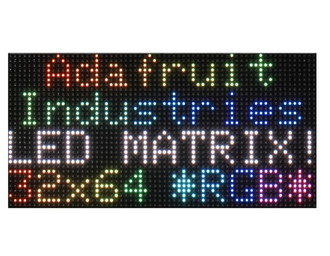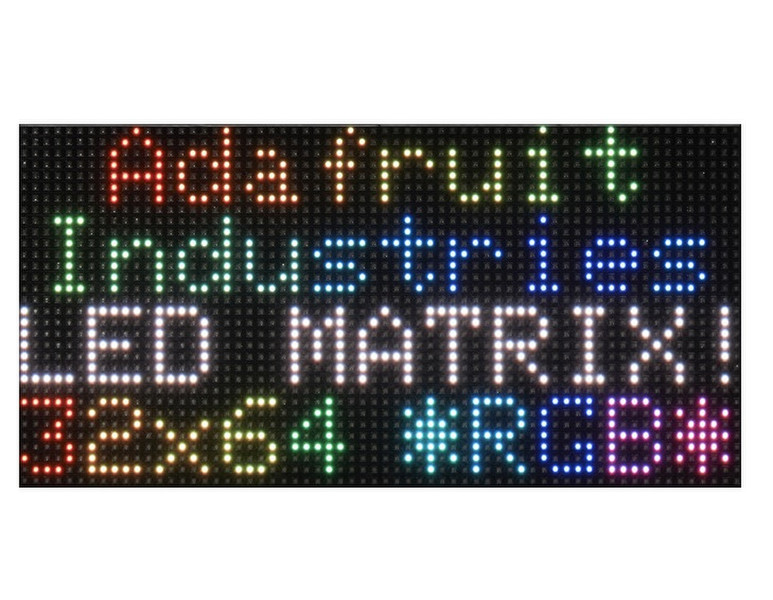目錄的
-
目錄的
- Antiquitäten & Kunst
- Auto & Motorrad: Fahrzeuge
- Baby
- Bücher
- Camping & Outdoor
- Feinschmecker
- Garten & Terrasse
- Haushalt & Wohnen
- Haustierbedarf
- Heimwerken & Garten
- IT和电子
- Kleidung & Accessoires
- Modellbau
- Musik
- PC- & Videospiele
- Sammeln & Seltenes
- Spielzeug
- TV, Video, DVD
- Telekommunikation
- Uhren & Schmuck
- Wellness & Beauty
- fashion & lifestyle
- institutional food services equipment
- medical equipment, accessories & supplies
- 个人护理
- 休闲爱好
- 办公设备,用品和配件
- 商业与工业
- 家居,建筑,装修
- 家用电器
- 摩托车及配件
- 武器和弹药
- 照相机
- 花园和庭院
- 运动,娱乐及休闲
- 食物
- 高保真音響
Filters
Search
Adafruit 2278
凡购买和价格 (Advertising *)
顶部
技术特点
顶部
产品特点
| 显示类型 | LED |
|---|---|
| 屏幕尺寸 | 64 x 32 mm |
64 x 32 RGB LED Matrix - 4mm pitch
Bring a little bit of Times Square into your home with this sweet 64 x 32 square RGB LED matrix panel. These panels are normally used to make video walls, here in New York we see them on the sides of busses and bus stops, to display animations or short video clips. We thought they looked really cool so we picked up a few boxes of them from a factory.
<b>This version is the 4mm pitch 64x32 RGB LED Matrix. Please note you cannot use an Arduino UNO to drive this size, its way too big!</b>
Use an Arduino Mega, Raspberry Pi, BBB or other device that can handle displaying to RGB matricies and has plenty of RAM.
This is a lot like our 3mm pitch 64x32 RGB LED matrix panel, but The LEDs on this panel are farther apart (a 4mm pitch) so you won’t have be really close to appreciate it. It's made to look good indoors, even with a wide-angle view (160 degrees) and look great in ambient light. If you are looking for a wider pitch for a farther view distance, check out our 6mm pitch 64x32 RGB LED Matrix or our 5mm pitch 64x32 RGB LED Matrix.
This matrix has 2048 bright RGB LEDs arranged in a 64x32 grid on the front. On the back there is a PCB with two IDC connectors (one input, one output: in theory you can chain these together) and 12 16-bit latches that allow you to drive the display with a 1:16 scan rate.
These displays are technically 'chainable' - connect one output to the next input - but our Arduino example code does not support this (yet). It requires a high speed processor and more RAM than the Arduino has!
This matrix has 2048 bright RGB LEDs arranged in a 64x32 grid on the front. On the back there are two IDC connectors (one input, one output: in theory you can chain these together) and 12 16-bit latches that allow you to drive the display with a 1:16 scan rate.
These panels require 13 digital pins (6 bit data, 7 bit control) and a good 5V supply, up to 4A per panel. We suggest our 4A regulated 5V adapter and then connecting a 2.1mm jack. Please check out our tutorial for more details!
- A single 64x32 RGB panel,
- An IDC cable
- A plug in power cable
- We also include 4 mounting screws and mini-magnets (it appears these are often mounted on a magnetic base).
Keep in mind that these displays are designed to be driven by FPGAs or other high speed processors: they do not have built in PWM control of any kind. Instead, you're supposed to redraw the screen over and over to 'manually' PWM the whole thing. On a 16 MHz Arduino Mega, we managed to squeeze 12-bit color (4096 colors) with 40% CPU usage but this display would really shine if driven by any FPGA, CPLD, Propeller, XMOS or other high speed multi-core controller. The good news is that the display is pre-white balanced with nice uniformity so if you turn on all the LEDs it's not a particularly tinted white.
<b>This version is the 4mm pitch 64x32 RGB LED Matrix. Please note you cannot use an Arduino UNO to drive this size, its way too big!</b>
Use an Arduino Mega, Raspberry Pi, BBB or other device that can handle displaying to RGB matricies and has plenty of RAM.
This is a lot like our 3mm pitch 64x32 RGB LED matrix panel, but The LEDs on this panel are farther apart (a 4mm pitch) so you won’t have be really close to appreciate it. It's made to look good indoors, even with a wide-angle view (160 degrees) and look great in ambient light. If you are looking for a wider pitch for a farther view distance, check out our 6mm pitch 64x32 RGB LED Matrix or our 5mm pitch 64x32 RGB LED Matrix.
This matrix has 2048 bright RGB LEDs arranged in a 64x32 grid on the front. On the back there is a PCB with two IDC connectors (one input, one output: in theory you can chain these together) and 12 16-bit latches that allow you to drive the display with a 1:16 scan rate.
These displays are technically 'chainable' - connect one output to the next input - but our Arduino example code does not support this (yet). It requires a high speed processor and more RAM than the Arduino has!
This matrix has 2048 bright RGB LEDs arranged in a 64x32 grid on the front. On the back there are two IDC connectors (one input, one output: in theory you can chain these together) and 12 16-bit latches that allow you to drive the display with a 1:16 scan rate.
These panels require 13 digital pins (6 bit data, 7 bit control) and a good 5V supply, up to 4A per panel. We suggest our 4A regulated 5V adapter and then connecting a 2.1mm jack. Please check out our tutorial for more details!
- A single 64x32 RGB panel,
- An IDC cable
- A plug in power cable
- We also include 4 mounting screws and mini-magnets (it appears these are often mounted on a magnetic base).
Keep in mind that these displays are designed to be driven by FPGAs or other high speed processors: they do not have built in PWM control of any kind. Instead, you're supposed to redraw the screen over and over to 'manually' PWM the whole thing. On a 16 MHz Arduino Mega, we managed to squeeze 12-bit color (4096 colors) with 40% CPU usage but this display would really shine if driven by any FPGA, CPLD, Propeller, XMOS or other high speed multi-core controller. The good news is that the display is pre-white balanced with nice uniformity so if you turn on all the LEDs it's not a particularly tinted white.
-
支付方式
我们接受:













